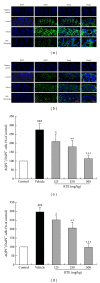Rhubarb tannins extract inhibits the expression of aquaporins 2 and 3 in magnesium sulphate-induced diarrhoea model
- PMID: 25215286
- PMCID: PMC4151595
- DOI: 10.1155/2014/619465
Rhubarb tannins extract inhibits the expression of aquaporins 2 and 3 in magnesium sulphate-induced diarrhoea model
Retraction in
-
RETRACTION: Rhubarb Tannins Extract Inhibits the Expression of Aquaporins 2 and 3 in Magnesium Sulphate-Induced Diarrhoea Model.Biomed Res Int. 2025 Jul 31;2025:9768597. doi: 10.1155/bmri/9768597. eCollection 2025. Biomed Res Int. 2025. PMID: 40777206 Free PMC article.
Abstract
Tannins, a group of major active components of Chinese rhubarb and widely distributed in nature, have a significant antidiarrhoeal activity. Aquaporins (AQPs) 2 and 3 play important roles in regulating water transfer during diarrhoea. The present study aims to determine the effect of the total tannins extract of rhubarb on aquaporins (AQPs) 2 and 3 in diarrhoea mice and HT-29 cells both induced by magnesium sulphate (MgSO4). Our results showed that rhubarb tannins extract (RTE) significantly decreased the faecal water content in colon and evaluation index of defecation of diarrhoea mice. Interestingly, RTE could markedly reduce the mRNA and protein expression levels of AQPs 2 and 3 in apical and lateral mucosal epithelial cells in the colons of diarrhoea mice and HT-29 cells both induced by MgSO4 in a dose-dependent manner. Furthermore, RTE suppressed the production of cyclic monophosphate- (cAMP-) dependent protein kinase A catalytic subunits α (PKA C-α) and phosphorylated cAMP response element-binding protein (p-CREB, Ser133) in MgSO4-induced HT-29 cells. Our data showed for the first time that RTE inhibit AQPs 2 and 3 expression in vivo and in vitro via downregulating PKA/p-CREB signal pathway, which accounts for the antidiarrhoeal effect of RTE.
Figures







References
-
- Mandomando IM, Macete EV, Ruiz J, et al. Etiology of diarrhea in children younger than 5 years of age admitted in a rural hospital of Southern Mozambique. The American Journal of Tropical Medicine and Hygiene. 2007;76(3):522–527. - PubMed
-
- Palombo EA. Phytochemicals from traditional medicinal plants used in the treatment of diarrhoea: modes of action and effects on intestinal function. Phytotherapy Research. 2006;20(9):717–724. - PubMed
-
- Hardin JA, Wallace LE, Wong JFK, et al. Aquaporin expression is downregulated in a murine model of colitis and in patients with ulcerative colitis, Crohn’s disease and infectious colitis. Cell and Tissue Research. 2004;318(2):313–323. - PubMed
-
- Kunzelmann K, Mall M. Electrolyte transport in the mammalian colon: mechanisms and implications for disease. Physiological Reviews. 2002;82(1):245–289. - PubMed
-
- King LS, Agre P. Pathophysiology of the aquaporin water channels. Annual Review of Physiology. 1996;58:619–648. - PubMed
Publication types
MeSH terms
Substances
LinkOut - more resources
Full Text Sources
Other Literature Sources
Medical

